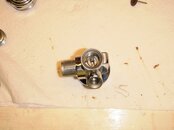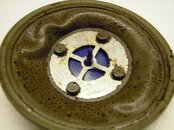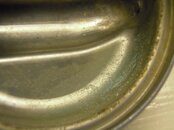Emphasis on the "
periodic cleaning." The more frequent the better.
I have three of these regs. One I bought new back in 1978. When I bought it, the dealer who sold it to me walked me through the servicing procedure step by step. It was he who told me to put a light coat of grease on the inside of the piston barrel. He also told me to remove the piston and wipe out the barrel often to remove any grit or contaminants that the grease catches, especially after diving in silty or sandy water. Since it only takes about twenty minutes to do this, I long ago got into the habit of (after a day of diving) wiping off the piston and the interior surface of the barrel, then relubing the O rings, piston and barrel. This regulator is still mint inside and looks like new.
The other two Aquarius regs I have I bought used. One had a small amount of corrosion in the barrel and the other has lost all of its chrome in the barrel. I suppose these two had owners who were not as anal as I am about taking care of their equipment. They are still serviceable and work perfectly, though.
I guess it really depends on how much time an Aquarius' owner wants to devote to its care. I really don't mind sitting down for a few quiet minutes in the evening with my Aquarius to see to its needs. But like I said, I am rather anal about taking care of my gear. Since water gets into the piston barrel anyway, the grease on the O rings is going to collect grit regardless of whether the rest of the barrel is greased or not. Just rinsing it out will not remove it. So, whether you opt for complete cover of the barrel interior or just the O rings, it really doesn't hurt to remove the piston after a dive trip and wipe the reg out with a soft, clean cloth, then replace it after giving it a fresh lube. Like I said, it only takes a few minutes.
On the other hand, I once knew a guy who bought an Aquarius brand new and dived it virtually every weekend (spring, summer and fall) for five or six years and never serviced it. He would dive it then bring it home and hang it on the wall of his unheated garage. It hung there through spring, summer, winter and fall. One day it started losing air out of the first stage. Back on the surface, he dumped it into a trash can and went off to buy another reg.
I rescued that Aquarius from the garbage and took it home. The insides were filthy and corroded. The big O ring on the piston had dried out and had snapped. This was the source of the air loss. I soaked the reg in white vinegar and cleaned the corrosion out with a small, soft brush. All of the chrome inside was gone but the brass was still smooth and free of pits. I overhauled both stages of that old Aquarius with new O rings, flipped the HP seat and replaced the filter. The second stage needed only to by cleaned and a new LP seat installed. I gave it to my best friend, Fuzz, and he used it for seven or eight years as a back-up regulator. Tough little puppies, I tell you!
I once completely overhauled my Aquarius in a tent by the light of a kerosene lantern. My tools consisted of a couple of screwdrivers, a piece of wire (to push out the HP seat and the filter), a small crescent wrench and a pocketknife. It took less than an hour.
Setting the IP of an Aquarius by gauge is an optional procedure. Page 83 of the manual simply says to install the base plug (cap) flush with the regulator body. The manual says that the IP "can" be adjusted and that the IP range is 128-132 @2400 psi tank pressure. Installing the base plug flush with the body gives an IP between 130 and 140 @2400 psi, depending on the strength of the two piston springs. So it is up to the person doing the servicing whether or not it's worth the extra step to fine tune the IP. Personally, I like keeping mine set as high as possible so that airflow is at maximum at lower tank pressures. You can't overpressure the IP on these regs. The base plug cannot be loosened far enough. It just pops out.
If the HP seat looks worn, just remove it from the piston and flip it over. These seats are two sided.
I am a huge fan of the USD Aquarius. I love that little reg and I'm always on the lookout for good ones to add to my collection.









